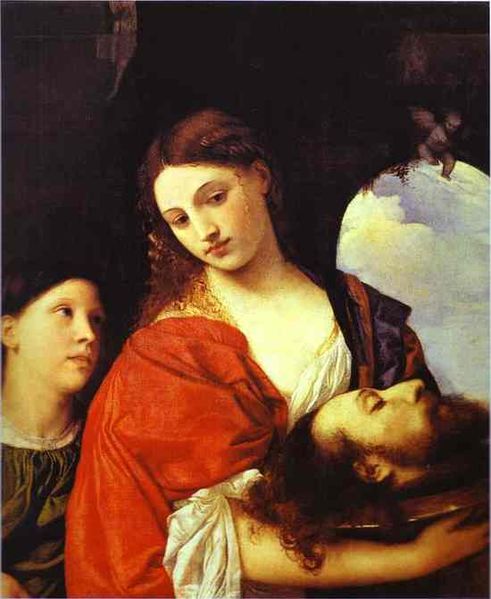| Titian | |
|---|---|
 |
|
| Born | Tiziano Vecelli 1488/1490 Pieve di Cadore |
| Died | Aug. 27, 1576 (at age 85-88) Venice |
| Nationality | Italian |
| Movement | High Renaissance |
| Field | Painting |
| Works | View Complete Works |
Tiziano Vecellio, known as Titian in English, was born in the small alpine village of Pieve di Cadore, which is located near the Austrian border. As for the date of his birth, no one really knows. It was undocumented, but scholars accept the period from 1482-1490 for his birth years. His parents were respectable people of modest means. In 1498, Titian and his brother Francesco were sent to Venice to start training as painters in the workshop of Sebastiano Zuccato who specialized in mosaics.
While his brother stayed there to study, Titian left and went to be an apprentice for Gentile and Giovanni Bellini. His earliest surviving work is from there, Jacopo Pesaro being presented by Pope Alexander VI to Saint Peter, 1502-1508. He left the Bellini’s, and went to study under Giorgione. He was his personal assistant until his death in 1510. Their styles are hard to tell apart, and their paintings, unless signed or documented, are sometimes labeled to be painted by both artists, since no one could really tell the difference.
Titian’s first big commission was in 1510. He was to paint the Scuola Del Santo in Padua. Three years later, when business started doing well. He opened his own workshop and was able to hire two assistants. In 1516, he was commissioned to paint the high altar in the Church of Maria Gloriosa dei Frari in Venice. When finished, Titian was the most celebrated artist in Venice. This is the piece that brought him the fame and glory that carried him through the Renaissance.
 Afterwards, he was asked by the Duke of Ferrara, Alfonso d’Este to paint some mythological paintings for him in 1518; Worship of Venus, Bacchus and Ariadne, and The Bacchanal of the Andrians. Most art during this time was religious, so this move into pagan subjects was relatively new and not popularized. The vibrancy of the figures is due to the oil paint, which was a relatively innovative technique. Ordinarily, they would be encaustic, which means paint mixed with wax, or tempura, which is paint mixed with egg whites.
Afterwards, he was asked by the Duke of Ferrara, Alfonso d’Este to paint some mythological paintings for him in 1518; Worship of Venus, Bacchus and Ariadne, and The Bacchanal of the Andrians. Most art during this time was religious, so this move into pagan subjects was relatively new and not popularized. The vibrancy of the figures is due to the oil paint, which was a relatively innovative technique. Ordinarily, they would be encaustic, which means paint mixed with wax, or tempura, which is paint mixed with egg whites.
His next work, Martyrdom of St Peter Martyr has been lost. Man with a Glove, 1522, is a portrait of an unknown, but probably moderately wealthy man; Madonna with Saints and members of the Pesaro Family, or the Pesaro Madonna, 1526. This piece was a monumental order as well. The Pesaro’s were a major family, and they funded much art during the Renaissance. This piece shows the family having a sakura conversasiona, or a sacred conversation with Madonna, which is a common scene in privet art.
In 1525, Titian married Cecilia, to legitimize his son Pomponio, whom they had had some time before. In due course, they had two more children, Orazio and Lavinia, but regrettably, Cecilia died giving birth to Lavinia. To take care of the kids, Cecilia’s sister Orsa came to live with them. The two sons eventually became assistants to Titian, while the daughter was married off when she came of age. Unfortunately, she died at child birth too.
Around 1533, Titian was hired as a court painter for Charles V of the Holy Roman Emperor, and awarded the title Count Palatine and knight of the Golden Spur by the Emperor. To thank Charles for the job, he gave Charles V a self portrait of him-self, which Charles cherished very much. The Golden Spur is given out to people who have contributed to the glory of the Catholic Church.
In 1538, he painted Venus of Urbino. She is naked, lying on the chaise in a sensual position, with a small dog on the floor next to it. Since the dog is a symbol of fidelity and it’s asleep, is suggest that the woman is unfaithful. This was supposed to be a wedding present for the Duke of Urbino’s new wife. It is based off of Giorgione’s Sleeping Venus, for they have the same pose, but Giorgione’s is not suggesting erotic things like Titian’s is.
This painting would inspire so much art in the future. Ingres thought this work was one of the best ever created, and made Grande Odalisque. Odalisque is a Turkish concubine, so both paintings have the same erotic tone, just different settings. Éduard Manet loved it so much, he used the same idea in Olympia, only the woman was a prostitute in his piece, and she had a cat next to her. This painting is considered to be a favorite by many artists for its stark beauty, and blatant sexuality.
Titian died on August 27, 1576 because of the plague; he was approximately 80 years old, but we can’t be sure. Both his sons died as well from it. Titian is buried at the Church of Maria Gloriosa dei Frari to commemorate him. The mansion that they lived in was raided by thieves, so most of Titian’s possessions are long gone. His brother Francesco became an artist as well, but never had the popularity that Titian had.